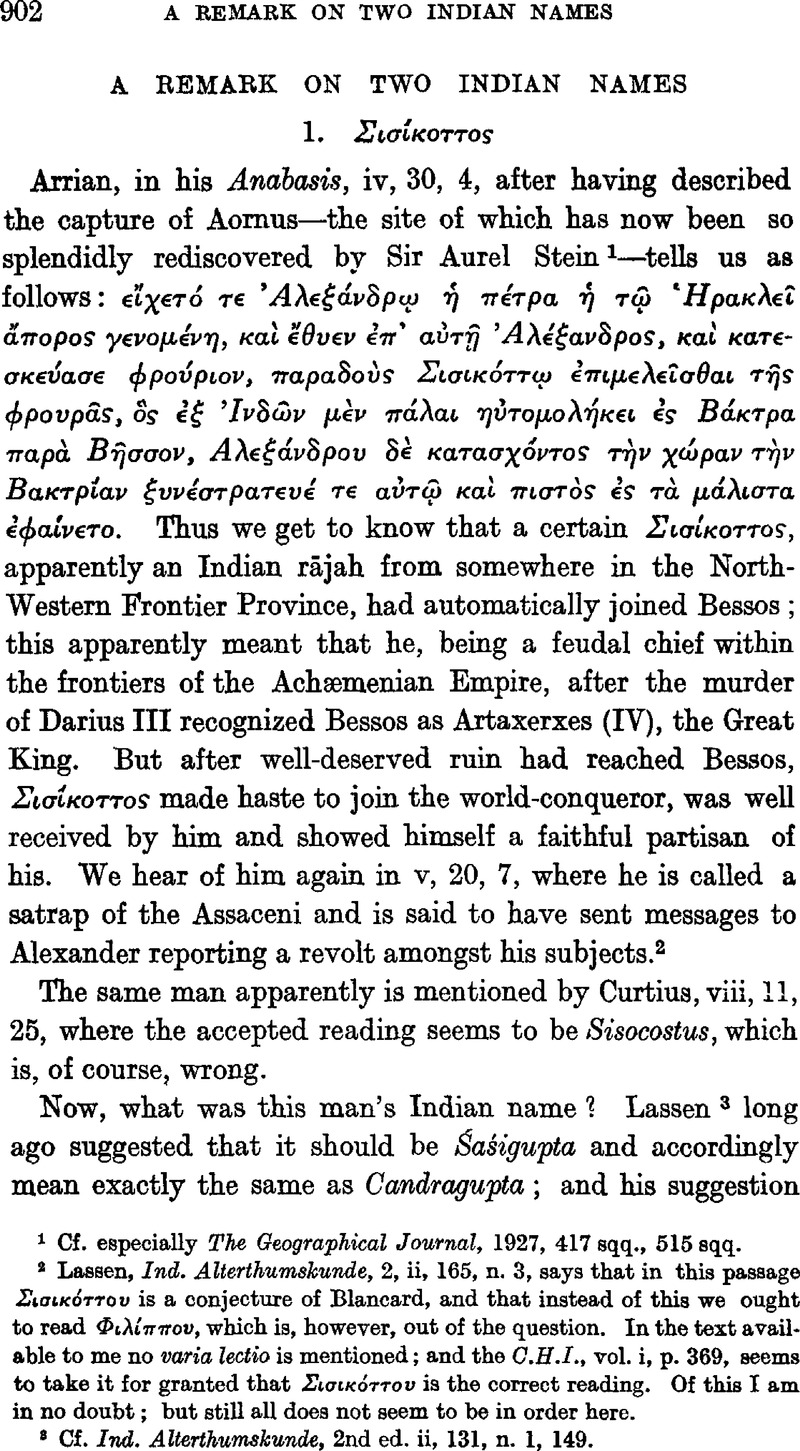No CrossRef data available.
Article contents
A Remark on Two Indian Names
Published online by Cambridge University Press: 15 March 2011
Abstract

- Type
- Miscellaneous Communications
- Information
- Copyright
- Copyright © The Royal Asiatic Society 1928
References
page 902 note 1 Cf. especially The Geographical Journal, 1927, 417 sqq., 515 sqq.
page 902 note 2 Lassen, , Ind Alterthumskunde, 2, ii, 165, n. 3Google Scholar, says that in this passage Σισικόττουis a conjecture of Blancard, and that instead of this we ought to read Φιλίππου, which is, however, out of the question. In the text available to me no varia lectiois mentioned; and the C.H.I., vol. i, p. 369, seems to take it for granted that Σισικόττουis the correct reading. Of this I am in no doubt; but still all does not seem to be in order here.
page 902 note 3 Cf. Ind. Alterthumskunde, 2nd ed. ii, 131, n. 1, 149.
page 903 note 1 Cf.C.H.I., vol. i, pp. 350, 356, 369Google Scholar.
page 903 note 2 Indien, p. 44 (= Ersch-Gruber, Allg. Encydopedie, 2 Section, vol. xvii— xviii, p. 44).
page 903 note 3 Cf.Hilka, , Die altindischen Personennamen, p. 103 seq., a useful but unfortunately not quite trustworthy workGoogle Scholar.
page 904 note 1 Cf.Belvalkar, and Ranade, , History of Indian Philosophy, ii, 108Google Scholar.
page 904 note 2 The above explanation, of course, presupposes that Σισίκοττος has nothing to do with certain Persian names like Σισιμάκης(vv. 11., Σισαμάκης, Σισμάγκης, Συσμάγκης), Herod., v, 121; Σισιμίθρης, the satrap of Naura, Curtius, viii, 2, 19. 4, 19; Plutarch Alexander, 58, 2 (vv. 11., Συσιμίθρης, cf. v. Schwarz Alexander des Grossen Feldziige in Turkestan (1893), p. 88), besides whom there was also a Σουσαμίθρης, the cousin of Pharnabazos and murderer of Alcibiades (Corn. Nepos., 6, 10, 3; Plutarch Alcib., 39, 1), and Sisigambisor Sisygambis, the daughter of Ostanes, sister and wife of Arsanes, and mother of Darius III (another form of the name, mentioned by Diodorus, seems to be Σισύγγαμβρις). The origin of these Persian names seems to be quite unknown.
page 904 note 3 Corpus Inscr. Ind., vol. iii, No. 14Google Scholar.
page 904 note 4 This forms the syntactical connexion with the preceding verses 8–10.
page 905 note 1 In this connexion it should be remarked that Parṇaśabara does, of course, not mean “a Śabara living on leaves” as suggested in the Pet. Dict., but “a Śabara clad in leaves”, a fairly well-known thing. Speaking of Parṇavalka we are also reminded of Yajña-valka, the supposed ancestor of the great Yājñavalkya. That name was misinterpreted by Śaṃkara; and ProfessorWackernagel, , Zeitschr. f. vgl. Sprachforschung, vol. xlvi, p. 271Google Scholar, has given an ingenious but unacceptable explanation of it. Yajña-valka must mean “sacrificial splint”, viz. a splint of palāśa-wood used for curdling the sacrificial milk (the wood of the Butea frondosa, of course, contains plenty of astringents, cf. Watt, , Commercial Products of India, p. 189Google Scholar).


